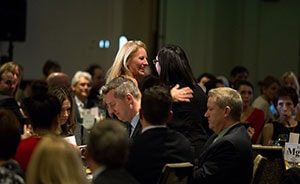The following is a transcript of a question-and-answer session, conducted over the FSH Society’s Facebook page, with Julie Hershberg, PT, DPT, NCS. Hershberg is a physical therapist who is a Board Certified Neurologic Specialist. She practices at [re+active] physical therapy & wellness and is an instructor in Doctor of Physical Therapy program at USC.
I have been recently diagnosed. I have always been quite active. However, I have been told to stop my kettlebell class, as well as using any free weights, and go swimming instead. Is this something you agree with?
The general thought in the past is that strength training was harmful for FSHD—that is not the case now. Moderate-intensity strength and aerobic exercises have been found to be safe. So the answer is not a universal recommendation to stop strength training! However, it would be important to know how you are performing the exercises so that you are using the appropriate amount of resistance and not compensating or hurting yourself. I recommend a physical therapist to help give you guidance in this area!
I will link to an abstract for you to a Cochrane review of strength training. If you have any difficulty accessing the articles, send me a private message, and I will send those to you. I also have a presentation that I have done summarizing the literature for exercise and strengthening that I would be happy to pass on to you: http://www.ncbi.nlm.nih.gov/pubmed/23835682.
The conclusion of the Cochrane review: “Moderate-intensity strength training appears not to do harm, but there is insufficient evidence to conclude it offers benefit.” Cochrane review, 2013.
Someone told me about a zero-gravity treadmill. Would you recommend exercising on one of these for someone with FSHD?
Yes—I do love the Alter G anti-gravity treadmill for people who are able to walk. It is a supported treadmill that supports you with air (like water but without the resistance of water). I use this in my clinic, and now many gyms and physical therapy practices have them available: http://www.alterg.com.
My son, age 36, has FSH. His general doctor was concerned about his marked lordosis and his chronic back pain and sent him to a spine specialist. The general doc said she hoped there would be a brace that would improve the lordosis and pain. However, the spine specialist examined my son for a fair amount of time and determined that he would “fall over” if he wore a brace because it would throw off his way of walking. He seemed to be saying that our son’s lordosis and his peculiar center of gravity have forced him to adapt his walk in order to remain upright. A brace to alter the lordosis would throw off his equilibrium, causing him to fall. I realize you have not seen our son, but, in general, do you agree that a back brace could cause this kind of outcome?
The simple answer is that no one brace is a one-size fits all solution for lordosis and back pain and it really does take some trying different types of braces to see if a type of brace might be helpful. It is true that biomechanically the hyperlordosis can provide people hip and knee stability in stance and can be a compensation for weak hip extensors. It is possible that altering the alignment may make a person feel more unstable. However, I am not sure that an abdominal brace would particularly alter the alignment enough to cause a problem.


I have been using the AlterG treadmill for a few months and it has been amazing as it can hold me up while walking. I have not walked for two years but they started me at 20% body weight and very slowly moving my legs. I now can walk at 62% body weight and can walk over a mile. I will soon be trying to walk with a walker.